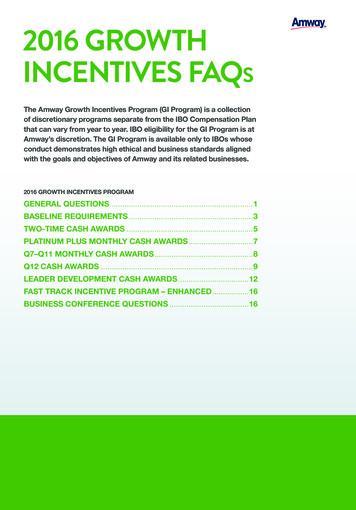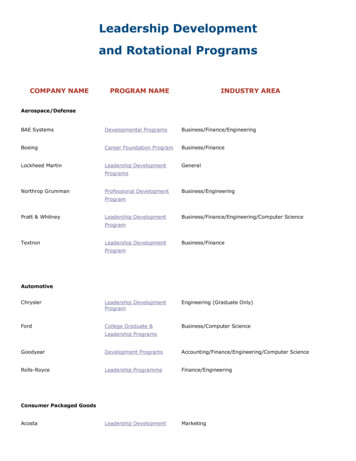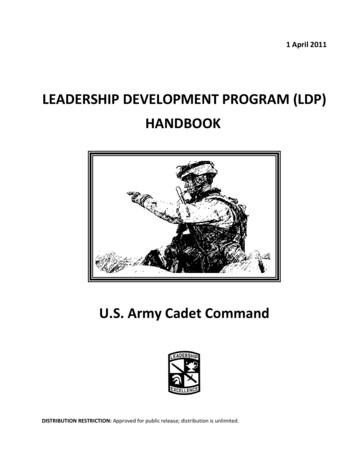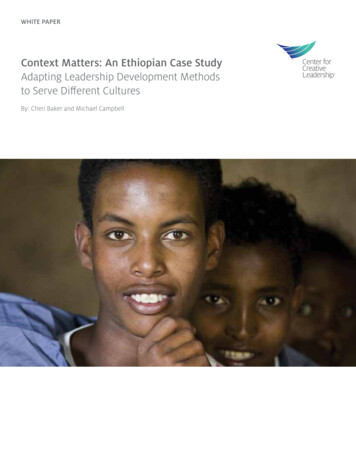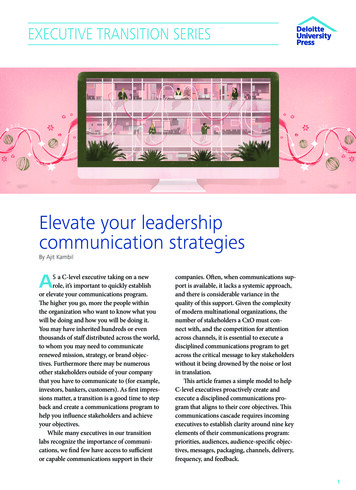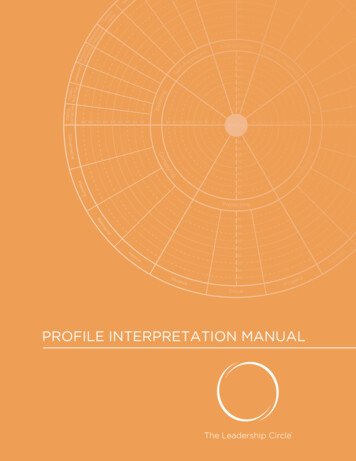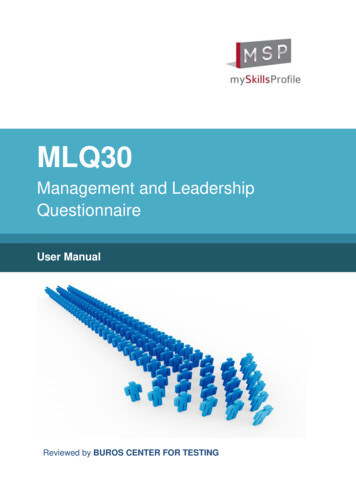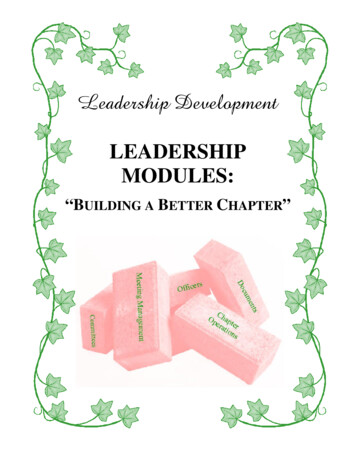
Transcription
Leadership DevelopmentLEADERSHIPMODULES:“BUILDING A BETTER CHAPTER”
STATEMENT OF PURPOSEThese Leadership Modules have been developed to meet your chapter’s needs. Thetraditional role of today’s leaders has rapidly changed and expanded. Today’s leadersmust be strategic thinkers who are goal focused and are accountable. To do thiseffectively, many essential skills are needed to build and maintain a positive andproductive chapter. These modules provide detail leadership principles that are necessaryto prepare sorors to meet Alpha Kappa Alpha Sorority, Inc., commitment to service. TheLeadership Modules also give examples of increasing emotional intelligence andleadership competencies for effective chapter operations.The Leadership Modules are designed to re-energize sorors at all levels. The material ispresented in a directed discussion format, which will allow for information sharing.Sorors will be encouraged to share their leadership experiences and chapter operations.The Leadership Modules are critical for chapter officers training and for chapter retreatplanning. These Leadership Modules give on-going processes, tools, and methods toapply and sustain high performance leadership principles in your chapters. We are allleaders in Alpha Kappa Alpha Sorority, Inc., - the modules are a hands-on leadershiptraining and development guide, with the goal to meet consistent leadership learning forall sorors.S OROR LINDA M . WH I T ES UPREME B ASILEUSTHE NATIONAL STANDARDS COMMITTEE 2004-2006Soror DeVera Y. Redmond, Xi Omega Chapter, North Atlantic Region, ChairmanSoror Marsha L. Brown, Gamma Theta Omega Chapter, South Atlantic RegionSoror Janice Campbell, Mu Psi Omega Chapter, International RegionSoror Ernita R. Cooper, Theta Omega Chapter, Central RegionSoror Anna K. Davis, Alpha Lambda Omega Chapter, Mid-Atlantic RegionSoror Barbara Franklin, Phi Iota Omega Chapter, South Eastern RegionSoror Cheryl P. Garnette, Iota Gamma Omega Chapter, North Atlantic RegionSoror Pame la R. Nunnelly, Kappa Chi Omega Chapter, Mid-Western RegionSoror Lucretia Payton-Stewart, Kappa Omega Chapter, South Atlantic, ResourceSoror Marsha Penn, Alpha Kappa Omega Chapter, South Central RegionSoror LaVern S. Tarkington, Delta Beta Omega Chapter, Far Western RegionSoror Beverly L. Tyler, Delta Psi Omega Chapter, Great Lakes Region
PUBLISHED BYALPHA KAPPA ALPHA SORORITY , INCORPORATED5656 SOUTH S TONY ISLAND AVENUECHICAGO , ILLINOIS 60637-1997 2005
LEADERSHIP MODULESModule I - Identifying LeadersModule II - OfficersModule III - CommitteesModule IV - Chapter OperationsModule V - Financial OperationsModule VI - Our DocumentsModule VII - Member Responsibilities and ProtocolModule VIII - Mentoring
MODULE IIdentifying LeadersTopics Covered in This Section:§Twelve Traits of True Leaders§Dimensions of Leadership§Common Leadership Styles§Ten Commandments of LeadershipExercises/Resources Included:(Use either transparencies or PowerPoint for presentations)§Successful Leadership Values§Pig Personality Test§Leadership Survival Kit§Leadership Myths§Leadership Qualities I Have/How I Know§Competency Model – Sorority LeadersPresentation Suggestions:(The time provided for this session will determine which activities/forms arecompleted or whether to distribute as information only.)§ Twelve Traits of True Leaders and/or Dimensions of Leadership –Present the information to the entire group for consideration and comparethe findings with the Master list developed by the whole group. Discussany differences, omissions or additions to reach group consensus.§Common Leadership Styles and/or The Ten Commandments ofLeadership - Present information contained within these documents forfurther consideration of skills desired.§Leadership Myths – Each person will individually complete this form asa pre-test to be reviewed at the end of the workshop as a post assessmentof knowledge or evaluation of beliefs.§Successful Leaders Values Form – Complete form individually andthen in pairs/triads depending on the number of participants in the group.
Presentations should be made to the whole group and recorded on a flipchart to develop a master list of values. Discuss values presented forclarification as appropriate.§Pig Personality Test, Change – Leadership Style Inventory, and/orLeadership Qualities I Have/How I Know: Use one or all of the selfassessments to determine individual leadership traits. Discuss briefly thefindings as a result of this exercise.§Individual Commitment- Select one/two areas from the self assessmentresults to determine individual needs for personal growth.§Leadership SOS Kit – Present information, instructing individuals toremove items from their kit as they are presented.§Competency Model – Sorority Leaders - Identify how various skill setsdiscussed earlier apply to our expectations of our officers at the differentlevels of leadership, e.g. committee chairs, local elected officers, regionalofficers, and national officers. Are they different? If so, to what extentare they different? How do we identify potential leadership among oursorors and develop them?§Final Activity – Review individual Pre-Test results to determine whatchanges would be made in their responses after the presentations andupon completion of the activities.Reference Documents to Use:§So Now You’re Elected (2005 Edition)§Fullan, Michael, (2002), The Change Leader, San Francisco: Jossey-Bass§White, Norma Solomon and Grays, Mattelia G., Former Supreme Basilei,(2000). And Who Shall Lead? – Leaders Guide, Alpha Kappa AlphaSorority, Inc. Publisher§Covey, Stephen R., Seven Habits of Highly Effective People, (1989)§“Company of Leaders” Fast Company Magazine, June, 1999§Covey, Stephen R., The 8th Habit: From Effectiveness to Greatness,(2004)
TWELVE TRAITS OF TRUE LEADERS1.LEADERS ARE BOTH CONFIDENT AND MODEST. Sure, you need a healthy ego to lead—butyou also need to be strong enough to put ego aside when necessary. Being a leader is not aboutmaking yourself more powerful. It’s about making the people around you more powerful.2.LEADERS ARE AUTHENTIC. You earn the trust and respect of the people you work with whenyou know who you are—and when you “walk your talk.” Who believes in leaders who don’t believein themselves?3.LEADERS ARE LISTENERS. And great listening is fueled by curiosity. It’s hard to be a greatlistener if you’re not curious about other people. What’s the opposite of this curiosity? Grandiosity—the belief that you already have all the answers!4.LEADERS ARE GOOD AT GIVING ENCOURAGEMENT, AND THEY ARE NEVERSATISFIED. Leaders are always raising the stakes of the game for themselves and for their people.That means that they are always testing and building both courage and stamina throughout theorganization.5.LEADERS MAKE UNEXPECTED CONNECTIONS. They organize and lead conversationsamong people who don’t normally interact with each other, and they see the kinds of patterns thatallow for small innovations and breakthrough ideas.6.LEADERS PROVIDE DIRECTION. But that is different from providing answers. No single leaderis smart enough to know everything about where the markets are going, how technology is changing,and what competitors are plotting. You’re not in control, and you’re not really in charge. But you arein touch, and you are out front.7.LEADERS PROTECT THEIR PEOPLE FROM DANGER—AND EXPOSE THEM TOREALITY. The dirty little secret of life in organizations: Most people want leaders to insulate themfrom change, rather than mobilize them to face it. That’s why leadership is so hazardous.8.LEADERS MAKE CHANGE—AND STAND FOR VALUES THAT DON’T CHANGE. One jobof a leader is to help people identify what habits and assumptions must be changed for the chapter toprosper—and to ask, “Which values and operations are so central to our core that if we lose them, welose ourselves?”9.LEADERS LEAD BY EXAMPLE. They use small gestures to send big messages. Leaders have afundamental obligation to live their lives according to the principles they espouse. Remember: Youare always under a microscope.10. LEADERS DON’T BLAME—THEY LEARN. Even the smartest businesspeople around makemistakes. Remember when Bill Gates decided that the Internet wouldn’t have a big impact onMicrosoft’s business? These days, the right mind-set is an experimental mind-set: Try, fail, learn, andtry again.11. LEADERS LOOK FOR AND NETWORK WITH OTHER LEADERS. Want to make yourselfeven more effective as a leader? Want to heighten your influence and deepen your impact? Stopplaying the role of the Lone Ranger! Look for allies, network with like-minded colleagues—and helpthose people to become better leaders. Remember: It’s lonely at the top only if you place yourself on apedestal.12. THE JOB OF THE LEADER: MAKE MORE LEADERS. After you adopt these traits to makeyourself a leader, look around your organization. Do you see enough leaders at all levels to keep yourchapter changing and charging into the future? Remember: The team with the most and best leaderswins! Your ultimate task is not just to be a leader—it’s to make more leaders.(Adapted from an article introducing the Company of Leaders approach to grassroots leadership, in FAST COMPANY magazine, June 1999)
DIMENSIONS OF LEADERSHIPIntegrity:Leading through honesty and acceptance of personal responsibilitySelf-Renewal:Flexible, responsive leadership that makes good use of experienceFortitude:Acting with courage and confidence in the face of challengePerceiving:Looking beyond current details to the big pictureJudgment:Knowing what needs to be done and accurately anticipatingconsequencesPerforming:Getting results by overcoming barriers to effectivenessBoldness:An uncompromising approach that involves facing problems head-onTeam Building:Accomplishing results through others by getting them to worktogetherCollaboration:Sharing rewards and responsibility with others in the groupInspiring:Energizing, motivating, and encouraging others to pursue leaderdefined goalsServing:Taking cues from followers and providing assistance that others can’tget on their ownEnthusiasm:Pursuing objectives with passion and optimism, and attracting othersto the cause
Common Leadership StylesParticipative — If the leader presents a tentative decision which is subject to change or suggests theissue to the members, gets suggestions, and then makes the decision, we are dealing with a"participative" style. The leader identifies the purposes, the problems, and the means by which theactivities should be carried out; presents a tentative decision already made or seeks chapter opinion;then makes the decision. In this instance, the area of decision freedom for members is much greaterand the use of authority by the leader is much smaller than with the autocratic and consultative styles.This is a powerful motivator in enabling members to have some measure of influence and control overtheir activities.Democratic — Within a democratic style, the leader defines the limits of the situation and theproblem to be solved and asks the members to make decisions. The members have a relatively largearea of decision freedom. The boundaries of activity are set by the leader, who permits the members tomake decisions within those restrictions.Consultative — In this situation, the leader sells the decision or presents ideas and invites questionsfrom members. Specifically, the leader makes decisions concerning the work activity to be carried out,its purpose, how it is to be done, when, and by whom, and attempts to sell the members on thedecisions. The leader may recognize the possibility of some resistance and invite questions; however,unless overwhelming reasons cause a change in the decisions made, they stand.Eclectic — In this style of leadership, the leader selects from diverse styles. The strategies are madeup of components selected from diverse sources. In other words, the leader allows the situation,condition and/or circumstance determine the style of leadership.Autocratic — This style represents the leader who makes decisions and announces them to themembers. The total interacting relationship and the activity setting have been selected by the leader.Total control!!!!!
The Ten Commandments of LeadershipThou Cannot .So .1.Accomplish the goals of theorganizationYou must depend on those with whomyou work2.Do all the process activitiesYou must delegate authority andresponsibility3.Succeed without environmentalsupportYou must seek feedback from theenvironment and you must representyour organization to the environment4.Assume that thou art the onlyintelligent being in theorganizationYou must involve other organizationalmembers in the organizationalfunctions5.Survive without feedback tomembersEvaluation and discussion are critical6.Survive without feedback frommembersYou must create a climate of trust andshow a willingness to listen7.Satisfy all the people all the timeBut you should upset the right peoplefor the right reasons8.Keep thy position foreverYou must leave it for the right cause atthe right time9.Expect everything to go right allof the timeYou must not take the eventspersonally or allow others to take thempersonally10.Ignore your personal andprofessional needsYou must maintain your integrity andself in all situations
LEADERSHIP MYTHSState your personal beliefs (True or False):1. Leadership is a rare skill.2. Leaders are born, not made.3. Leadership exists only at the top of an organization4. Leaders are charismatic.5. The leader controls, directs, prods, and manipulates.
Successful LeadersVALUESDirections: Write down your top ten values1.2.3.4.5.6.7.8.9.10.Choose from this partial list or add your own:Accomplishment, achievement, adventure, ambition, authority, career, challenge, competition, country,discipline, duty, education, faith, family, freedom, good income, happiness, honor, influence, intellect,integrity, joy, love, loyalty, morality,Religion, patience, persistence, power, professionalism, rewards, self-re
apply and sustain high performance leadership principles in your chapters. We are all leaders in Alpha Kappa Alpha Sorority, Inc., - the modules are a hands-on leadership training and development guide, with the goal to meet consistent leadership learning for all sorors. SOROR LINDA M. WHITE SUPREME BASILEUS THE NATIONAL STANDARDS COMMITTEE 2004-2006 Soror DeVera Y. Redmond, Xi

